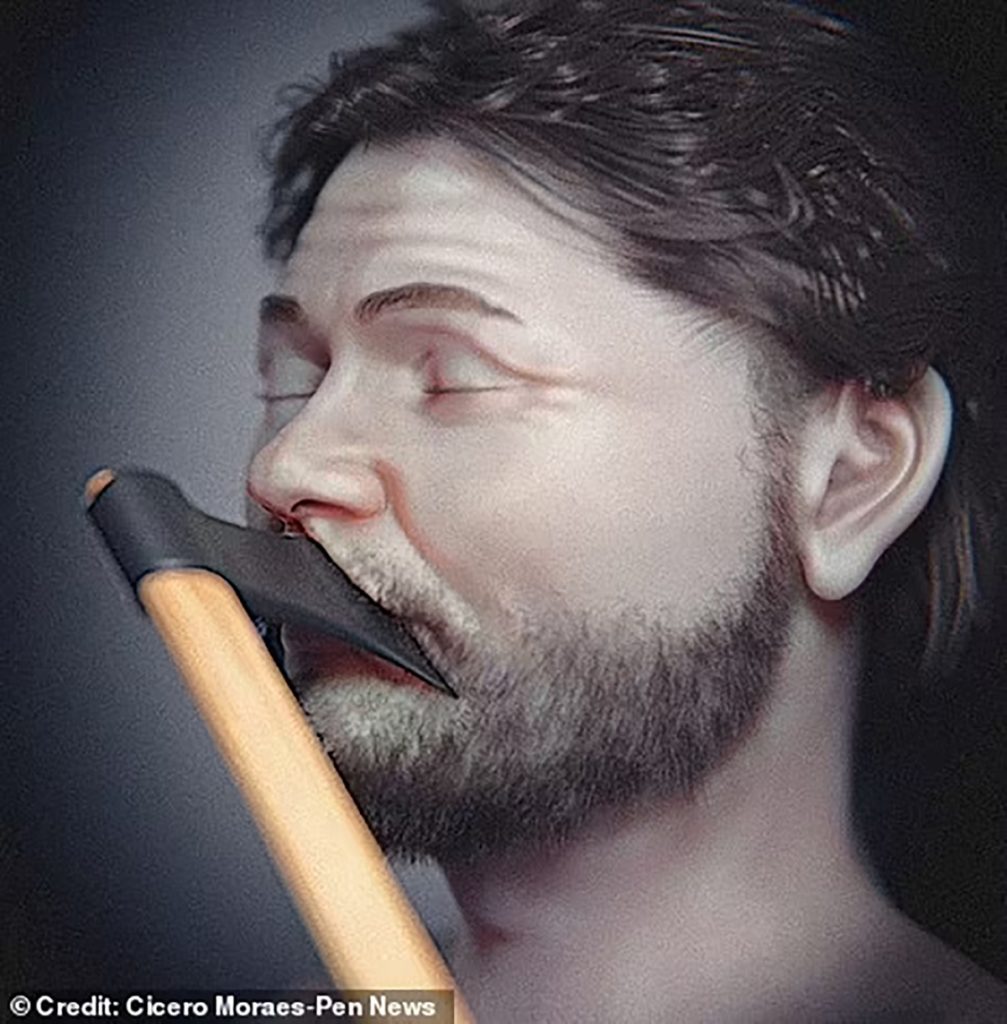The pages of history are filled with enthralling stories, yet one of the greatest challenges lies in accurately depicting events from centuries past. However, with the extraordinary progress in modern technology, scientists have managed to reconstruct the face of a man who perished during the brutal Battle of Visby in Sweden in 1361, one of the bloodiest confrontations in European history. This endeavor stands as a testament to humanity’s relentless quest to connect with and understand the lives of those who lived long ago.
The Battle of Visby was a catastrophic clash that claimed the lives of over 2,500 individuals, many of whom were peasants and elderly men ill-equipped to face the harsh realities of medieval warfare. The discovery of a mass grave on the serene Swedish island of Gotland revealed the remains of numerous victims of this historic conflict. The skeletal remains uncovered there told a story of despair, courage, and resilience, hidden beneath layers of time.

This remarkable finding sparked an ambitious scientific undertaking to reconstruct one of the fallen warriors’ faces and bring the past into vivid focus. Using state-of-the-art forensic techniques and cutting-edge technology, researchers meticulously pieced together the fragmented remains to unlock secrets preserved within the bones. Each step of the process aimed to revive a connection to this forgotten individual and shed light on the human experience of a turbulent era.
As scientists examined each bone, they utilized advanced forensic methods to reconstruct the facial features of the 14th-century warrior. Through their painstaking efforts, the shroud of anonymity surrounding this man’s identity began to lift. Layer by layer, his visage took shape, offering a glimpse into the life of someone who experienced the harsh realities of medieval Europe. This extraordinary accomplishment allowed the modern world to reconnect with the emotions, struggles, and sacrifices of a distant past.
The reconstructed face serves as more than just a visual representation; it is a poignant reminder of the countless untold stories buried beneath centuries of history. By restoring this warrior’s appearance, scientists provided a window into a world where ordinary individuals faced extraordinary challenges. This effort helps deepen our understanding of historical events and their profound impacts on the people who lived through them.
In times when the past often feels like a distant and inaccessible realm, science and technology have proven to be powerful tools for bridging the gap. This achievement underscores our collective determination to unravel the mysteries of history and honor the lives lost in its tumultuous sweep. The reconstructed face of the 14th-century warrior exemplifies how the fusion of science and artistry can illuminate hidden narratives and give voice to those who have long been forgotten.
Among the discoveries in the mass grave, the most striking was the skull of a medieval warrior, bearing the brutal marks of an ax that had cleaved his face in two. This gruesome artifact spoke volumes about the ferocity of the battle and the violence of his final moments. Brazilian 3D designer Cicero Moraes played a pivotal role in the effort to digitally reconstruct the shattered face, combining technological innovation with artistic precision. The warrior’s mouth, tragically severed, and his broken teeth stood as haunting reminders of the brutality he endured. Additional injuries above his eye and on his left cheekbone further revealed the physical toll of his fight. Despite the passage of centuries, the digital reconstruction offered a profoundly moving glimpse into the hardships and resilience that defined his existence.
Cicero Moraes meticulously examined the skull and began placing markers to outline the contours of the missing skin. Using only the features of the skull as a guide, he carefully calculated the proportions of the nose, mouth, and eyes. This process allowed him to reconstruct the warrior’s face with remarkable accuracy. However, when it came to details like hair and skin tone, a degree of artistic interpretation was necessary. Drawing on his expertise and a deep understanding of the historical period, Moraes infused the reconstruction with thoughtful details that honored the warrior’s memory while acknowledging the inherent limitations of the evidence.
A three-dimensional model of the skull, provided by the Swedish History Museum in Stockholm, became the foundation for Moraes’s work. With unwavering dedication, he meticulously crafted the intricate features of the face, ensuring an impressive level of precision and realism in the final depiction. The completed reconstruction captured the essence of the warrior’s appearance, offering a tangible link to a distant time. This collaborative effort, blending scientific methodology with artistic mastery, resulted in a work that not only honors the past but also showcases the incredible potential of modern technology to bring history to life.
The final reconstruction stands as a powerful testament to the ability of science and art to unite in the pursuit of historical truth. It vividly portrays the face of a man who lived through a tumultuous period, fought bravely, and ultimately paid the ultimate price. Through this achievement, we are reminded of the resilience of the human spirit and the importance of preserving and honoring the stories of those who came before us.
The story of this medieval warrior serves as a bridge between the present and the past, reminding us of the enduring value of exploring history. By piecing together the fragments of his life, scientists have illuminated not only the details of a specific moment in time but also the universal themes of struggle, sacrifice, and humanity. This reconstruction encourages us to reflect on the countless lives that have shaped the course of history and to appreciate the connections that bind us across the ages.





